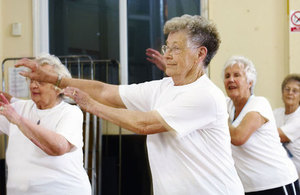Life expectancy at older ages is the highest it’s ever been
A new report by Public Health England (PHE) finds that life expectancy at older ages in England has risen to its highest ever level.

According to PHE’s report on recent trends in life expectancy at older ages:
- men can now expect to live for a further 19 years at age 65, 12 years at 75, 6 years at 85 and 3 years at 95
- women can expect to live for a further 21 years at age 65, 13 years at 75, 7 years at 85, and 3 years at 95
This follows our report last year of a drop in life expectancy at some older ages between 2011 and 2012.
The exception is females aged 85. Despite the rise in 2014, this is still at the same level as in 2011.
As before, there is variation in the figures for regions and local authorities. In all but one region of England, male and female life expectancy at age 65 increased between 2013 and 2014 and is higher in 2014 than in any other year presented. The exception is the North East, where male life expectancy was highest in 2013.
The majority of local authorities showed an increase or no change in life expectancy at age 65, however one quarter showed a decrease.
Professor John Newton, Chief Knowledge Officer at PHE said:
Overall the report presents a positive picture nationally and life expectancy is the highest it’s been since we started measuring.
People in England are living longer than ever and that makes achieving a good quality of life in later years even more important. Our current evidence shows that people are living longer but many are doing so in poor health. This report is an opportunity to remind people that, even during mid-life, it is not too late to improve your health. Most of us could make changes today, like stopping smoking, being more active or eating better, that would allow us to look forward to healthier later years.
The reasons for the variation in trend between local areas are not yet clear. PHE will continue to monitor these trends and analyse the data for 2015 as soon as possible.
Danny Dorling, Halford Mackinder Professor of Human Geography, University of Oxford said:
Although national average life expectancy continues to rise, in many parts of England improvements have stalled in recent years. There is an urgent need to determine why this is happening. Beneath the headline figures of this report there is evidence of worsening health for many older people in some parts of the country.
Dominic Harrison, Director of Public Health for Blackburn with Darwen Borough Council said:
With such a high proportion of deaths each year now in those over 80, continuing the improvement of life expectancy at older ages is critical to improving the life expectancy of the nation. It is great news that life expectancy is improving in some areas but worrying that life expectancy has decreased in others. Deaths in older age groups – who are amongst the most vulnerable in the population – may actually be telling us a lot about the risks being experienced by us all. I welcome this report - we need to look very carefully at what it might be telling us.
Background
-
Within England as a whole, life expectancy for both sexes at ages 65, 75, 85 and 95 increased between 2013 and 2014. This follows falls in life expectancy at some older ages between 2011 and 2012.
-
Between 2013 and 2014, male life expectancy increased by 0.3 years at age 65 and 0.2 years at ages 75, 85 and 95. Female life expectancy increased by 0.3 years at age 65, and by 0.2 years at ages 75, 85 and 95.
-
There is more variability in life expectancy at older ages among local authorities. For example, 63% of lower tier and unitary local authorities in England had an increase in male life expectancy at 65 years from 2011 to 2013 and 2012 to 2014 (the most recent time points), and 49% had an increase in female life expectancy at this age. However, 21% of lower tier and unitary local authorities had a fall in male life expectancy at 65 years, and 28% had a fall in female life expectancy at this age, although in half of areas the fall is only 0.1 years.
-
Between 2012 and 2013 almost all countries in the EU had an increase in life expectancy at older ages (2014 data are not yet available for all EU countries). UK male life expectancy increased at ages 65, 75 and 85, as did female life expectancy at age 75. The rise in the UK was smaller than the EU average rise in all these age groups, except males aged 85.
-
Danny Dorling and Dominic Harrison are formal members of PHE’s advisory group on mortality surveillance.